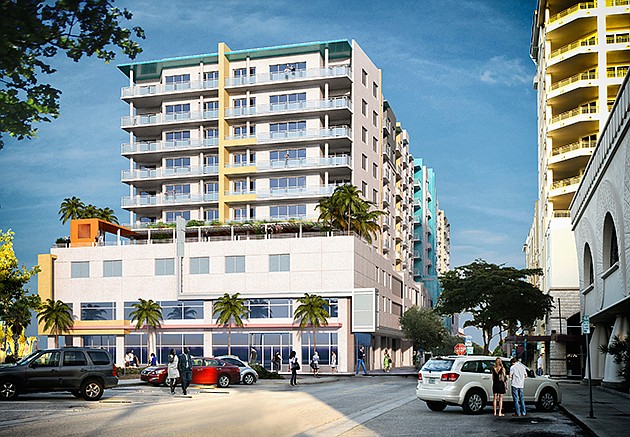- November 25, 2024
-
-
Loading

Loading

It's a nice problem to have — if you're an apartment developer.
Thanks to the last decade's condo conversions and subsequent foreclosure crisis, pent-up demand, a lack of new supply, population influx and changing tastes, apartment and rental landlords have been able to hike rents in Florida precipitously over the past few years.
In Pasco County, for example, rents spiked by 60% between 2001 and 2014, according to a leading rental research firm.
That surge has prompted developers and investors to propose new projects and bring new units online — especially in urban areas — at a rate not seen since the 1970s.
But with rent increases crushing gains in both inflation and wage growth, some analysts are questioning whether the multifamily sector is inflating a bubble of its own making.
“I'm worried about a bubble and a glut of new properties,” says John Michallidis, president and CEO of Real Property Management of Sarasota & Manatee, which manages rentals from Parrish to Punta Gorda.
“Builders are chasing money today, but I wonder how much they're considering what the market will be down the road. The question we have to ask is how much is the dog chasing its tail?”
The concern comes amid a new report from Columbia, Md.-based Enterprise Community Partners and Harvard University's Joint Center for Housing Studies, which found Florida ranks first in the nation for “severely burdened” renters — households that must devote 50% or more of their income to paying rent.
In all, nearly 175,000 households — equal to the populations of Clearwater and Sarasota combined — in Gulf Coast major metropolitan areas pay in excess of half their total take home pay for shelter and essential utilities, the study found.
Statewide, nearly one third of all renters pay 50% of their incomes for housing, and that figure is expected to rise by another 10% or more by 2025.
“This is going to get worse,” says Angela Boyd, managing director of Make Room, an Enterprise awareness campaign. “We're not going to be able to build our way out of this crisis, either, because primarily what's being developed are luxury apartments.”
Rents, meanwhile, have continued to climb. Between 2001 and 2014, in a six-county Gulf Coast region that includes Pasco, Polk, Pinellas, Hillsborough, Manatee and Sarasota counties, rent rates have surged an average of 35%, or $222.50 per month, according to statistics compiled by Tampa-based Triad Research & Consulting Inc.
In each county, rents have increased by at least 25% during that period, Triad notes.
Single-family homes have experienced the same escalations, Michallidis says. Average monthly rents in that segment pushed up 16.2% in the past year in Southwest Florida, to $1,822 monthly.
“Today it's all about location, location, location, lifestyle,” says Michael Slater, Triad's president and CEO. “If people want it badly enough, they pay for it, so people are now paying not 30% to 35% of take-home pay for rent, but 45% to 50% or above. And as a result, people are saying when is the bubble going to burst?
“What will happen eventually is consumers will say to themselves that they can move out of the urban core and pay $200 a month less in rent — but that hasn't happened yet,” Slater adds. “And I am still pretty optimistic about the market overall because we're running out of dirt for new projects.”
Slater and research firm Reis Inc. both project rents will continue to climb, through at least 2017, by 2% to 5% annually. Nationwide, rents have risen ahead of inflation and wages for the past four years, and household formation projections indicate that won't abate anytime soon.
Wages, by comparison, have inched up just 0.2% in 2015, according to the federal government.
For the time bring, at least, apartment developers don't seem overly concerned that rent spikes are going to price a significant number of renters out.
That's why in 2015 alone, more than one-third of all housing starts are multiunit in nature, the highest percentage since 1973, according to the National Association of Home Builders.
“A rent ceiling is an inherent risk in any new development,” says Jerome Hagley, an executive vice president at Carter, an Atlanta-based firm building rental towers in Tampa and Sarasota.
“We mitigate that by really having a handle on who our target market is,” he adds. “We're finding that people want mobility and top-notch amenities but they don't want to be tied to a 30-year mortgage. And what we see is that upscale condo rentals with amenities similar to ours are very hard to find.”
Carter isn't alone in coming to that conclusion.
Earlier this month, Camden Property Trust filed plans to construct a 297-unit complex in Tampa, near Gandy Boulevard. That deal follows plans by Wisconsin-based Continental Properties Co. this summer to develop 360 apartments on 51 acres in Sarasota County. The $50 million Springs at Bee Ridge project is scheduled for completion beginning next summer.
A series of other rentals are also scheduled for completion from Tampa to Naples that will add an estimated 10,000 new units by the end of 2017.
“There's no reason to foresee huge vacancies anytime soon,” Michallidis says. “People are coming here from out of state and out of the country. People want to be here, and with the trendlines, they want to be more mobile. I don't think that five years from now there'll be any abandoned properties.”
- K.L. McQuaid